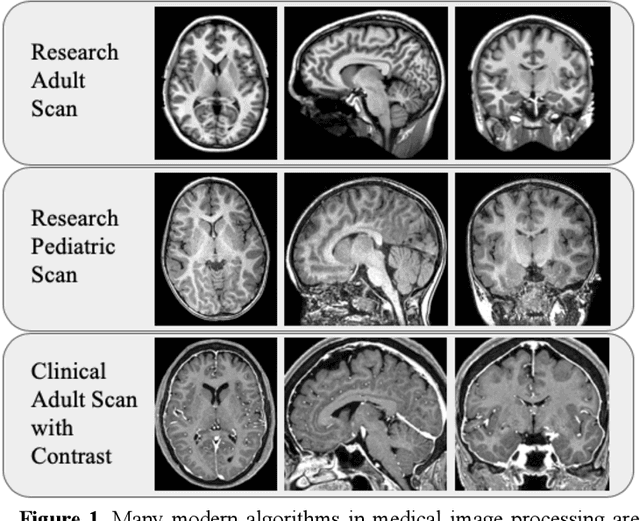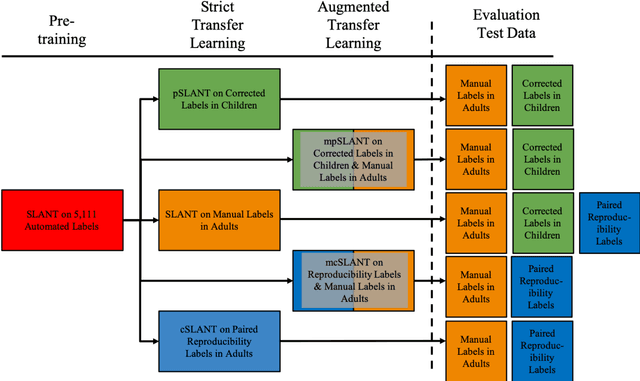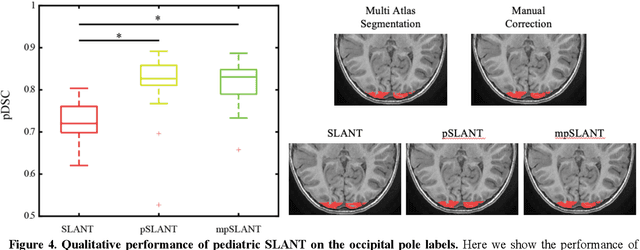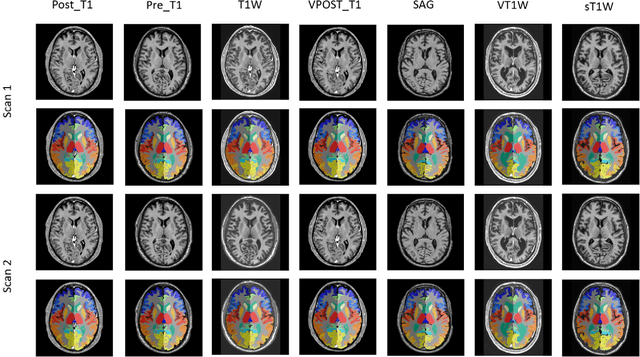Maureen McHugo
Generalizing Deep Whole Brain Segmentation for Pediatric and Post-Contrast MRI with Augmented Transfer Learning
Aug 13, 2019



Abstract:Generalizability is an important problem in deep neural networks, especially in the context of the variability of data acquisition in clinical magnetic resonance imaging (MRI). Recently, the Spatially Localized Atlas Network Tiles (SLANT) approach has been shown to effectively segment whole brain non-contrast T1w MRI with 132 volumetric labels. Enhancing generalizability of SLANT would enable broader application of volumetric assessment in multi-site studies. Transfer learning (TL) is commonly used to update the neural network weights for local factors; yet, it is commonly recognized to risk degradation of performance on the original validation/test cohorts. Here, we explore TL by data augmentation to address these concerns in the context of adapting SLANT to anatomical variation and scanning protocol. We consider two datasets: First, we optimize for age with 30 T1w MRI of young children with manually corrected volumetric labels, and accuracy of automated segmentation defined relative to the manually provided truth. Second, we optimize for acquisition with 36 paired datasets of pre- and post-contrast clinically acquired T1w MRI, and accuracy of the post-contrast segmentations assessed relative to the pre-contrast automated assessment. For both studies, we augment the original TL step of SLANT with either only the new data or with both original and new data. Over baseline SLANT, both approaches yielded significantly improved performance (signed rank tests; pediatric: 0.89 vs. 0.82 DSC, p<0.001; contrast: 0.80 vs 0.76, p<0.001). The performance on the original test set decreased with the new-data only transfer learning approach, so data augmentation was superior to strict transfer learning.
Reproducibility Evaluation of SLANT Whole Brain Segmentation Across Clinical Magnetic Resonance Imaging Protocols
Jan 07, 2019



Abstract:Whole brain segmentation on structural magnetic resonance imaging (MRI) is essential for understanding neuroanatomical-functional relationships. Traditionally, multi-atlas segmentation has been regarded as the standard method for whole brain segmentation. In past few years, deep convolutional neural network (DCNN) segmentation methods have demonstrated their advantages in both accuracy and computational efficiency. Recently, we proposed the spatially localized atlas network tiles (SLANT) method, which is able to segment a 3D MRI brain scan into 132 anatomical regions. Commonly, DCNN segmentation methods yield inferior performance under external validations, especially when the testing patterns were not presented in the training cohorts. Recently, we obtained a clinically acquired, multi-sequence MRI brain cohort with 1480 clinically acquired, de-identified brain MRI scans on 395 patients using seven different MRI protocols. Moreover, each subject has at least two scans from different MRI protocols. Herein, we assess the SLANT method's intra- and inter-protocol reproducibility. SLANT achieved less than 0.05 coefficient of variation (CV) for intra-protocol experiments and less than 0.15 CV for inter-protocol experiments. The results show that the SLANT method achieved high intra- and inter- protocol reproducibility.
 Add to Chrome
Add to Chrome Add to Firefox
Add to Firefox Add to Edge
Add to Edge